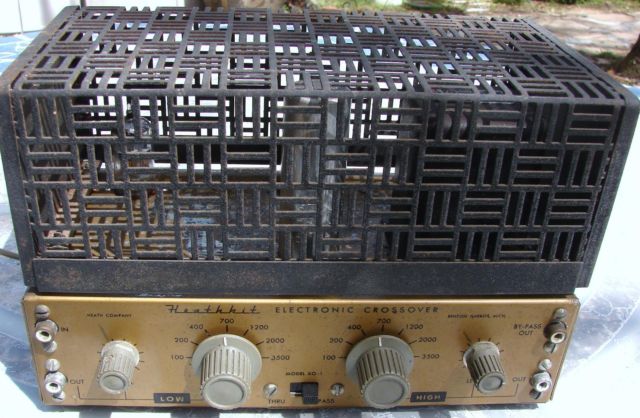
- #Xm26 tube electronic crossover network kit how to
- #Xm26 tube electronic crossover network kit drivers
- #Xm26 tube electronic crossover network kit driver
- #Xm26 tube electronic crossover network kit series
One goes to the Neo/FST binding posts and one to the Woofer system posts. I do this with my RM30s, by using two NuFOROCE 9.02's on each speaker.
#Xm26 tube electronic crossover network kit series
The binding post configuration on all the present (non-direct drive) RM series speakers allow for (maybe the best term is) "simple bi-amping" as well as "bi-wiring". I was justrying to add "clairity" (hope I didn't confuse). I believe the coil is in series with the bass/midbass, so shorting the coil bypasses the coil (one of the benefits of a first-order network). But I've been known to be wrong in the past.Īs for your soldering trick, that should work. So, one would hope that the midbass won't distort until frequencies that are well away from the crossover point. I'm not convinced that the midbass is going to be distorting because the midbass cutoff occurs at a relatively low point.
#Xm26 tube electronic crossover network kit driver
The only way it would reduce distortion of the midbass driver (or the bass driver) is if the 6dB slope allows some distortion to occur above the cutoff frequency. Also, why would this reduce distortion? It might reduce distortion of the midbass driver, but I doubt it would reduce distortion of the bass driver. I'm not sure why using a 24db/octave crossover instead of a 6db/octave crossover will let one drive the bass "harder" (the bass/midbass still has to be level matched with the midrange). For instance, with a 24db/octave slope, you might be able to have a higher crossover point with the same or lower amount of distortion. If you leave the coil in there, you don't get control over the crossover points. You really want to be able to control the crossover points and the level (if possible) for each of the two ranges you'll need.

It would conceivably work, but you wouldn't get the control you need. This of course assumes you haven't already spent numerous hours studying how speakers work. I'd ask Brian what he recommends specifically, period. The only way I would do it is with the knowledge of understanding everything Before I did anything. Did I say there's ALOT to designing a four way speaker?Ĭhanging crossover points and slopes can open up quite a can of worms imo. You'll also learn if you're very smart that there's alot to designing a four way speaker like the RM 40's. You'll learn real fast that even a 2 way speaker can be complicated to do well. Get on the Madisound and Partsexpress speaker building forums and ask questions. If you want to know what goes on in a speaker read Vance Dickason's "Loudspeaker Design Cookbook". If I were going to actively bypass I'd want something like a Tact unit so I had alot of control over what is happening. Once you actively biamp you bypass this "extra circuitry" which is necessary.ĭo what you want but be careful or you could end up with a can of worms I'd think.
#Xm26 tube electronic crossover network kit drivers
Reasons are that the designer may not only have the drivers high/low passed but also other parts that correct various issues.

The crossover is waiting, and I have the amps to make this happen.Īfter doing much research on the subject of biamping I came to the conclusion that active biamping can cause more harm than good quite easily. Yes, the slope is steep, but it's way down in frequency, and I am HOPING it will allow me to run the woofers harder, and provide the lower mid range warmth I crave so much. I think I read somewhere that Brian used, or uses a crossover with these slopes, and takes the Neo panels way down to 125 or 150 cycles! My crossover has 24 db per octave LinkwitZ Riley filters, and drivers will be in phase.
#Xm26 tube electronic crossover network kit how to
I need to know how to go into the RM 40's, and by pass the crossovers in the woofers, and the midrange hi pass section.īecause I will not be tri amping, I will need to use the passive tweeter crossover, and retain it s level control ? My RM 40's are the bi wire versions, w/o the switches, so you gotta either bi wire em, or run jumpers. Plus, it just so happens that my particular crossover has a CDWG EQ provision in it, as well as adjustable time delay. It also allows for amps suited for their particular task, like a big solid state honker on the bass, a warm, thick tube amp on the neo panels, and an airy tube amp up top on the spiral tweeters. I really wish I had a 3 way electronic crossover, then I could do away with the internal passive crossover altogether, as good as it is.īut I think actively bi amping allows for total control of the sound, better amplifier control of the drivers, and a reduction of distortion, because each amp is only handling a limited amount of the frequency range. I do not mean to "Bi Amp" them passively, I mean to bypass the internal crossovers, and use an active electronic crossover before the amplifiers. So, now it is time to do what i have always wanted to do to the RM 40's, Bi Amp them. I have acquired a Rane electronic crossover, got it cheap.


 0 kommentar(er)
0 kommentar(er)
